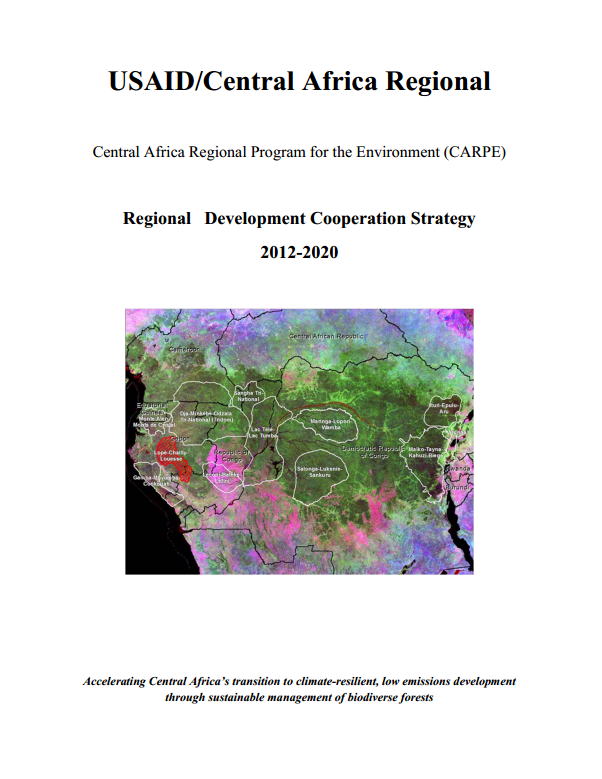More than 80 million people depend on Central Africa’s rich forests and associated natural resources for their livelihoods.
In addition to satisfying these immediate needs, the forest ecosystem provides services such as global climate regulation and a reservoir for unique and globally important biodiversity resources. However, despite the richness of the Congo Basin, the people of the Basin are among the poorest in Africa. The challenge facing regional governments, the global community and citizens of the Congo Basin alike is to strike a balance in the management of these natural resources to satisfy current needs while protecting and conserving the resource base for future generations. The prospect of new and emerging financing through partnerships opens a new avenue to sustain the ecological integrity of the Congo Basin.
The Central Africa Regional Program was established as a unique USAID/Central Africa Regional Operating Unit (OU) in 2003 to ensure unambiguous visible support for the USG commitment to the Congo Basin Forest Partnership (CBFP), an initiative announced at the International Summit for Sustainable Development in Johannesburg, South Africa in 2002. USAID then greatly expanded the Central Africa Regional Program for the Environment (CARPE) as the OU’s sole program to provide significant new financial and technical resources to this international initiative to conserve the planet’s second largest tropical rainforest and its threatened biodiversity. CARPE has assembled a large network of implementing partners including a large number of international conservation NGOs and federal agencies which count among them the Department of Interior (U.S. Fish and Wildlife Service, National Park Service, U.S. Geological Service), the National Aeronautics and Space Administration (NASA) and the U.S. Department of Agriculture (U.S. Forest Service, Foreign Agricultural Service). The CARPE Strategic Plan set forth an ambitious set of objectives for the period 2003-2011. A mid term evaluation in 2005-06 allowed USAID to consolidate and refine program activities and tactics while an External Evaluation completed in 2011 assessed progress against the stated goals and objectives. Among other findings, the External Evaluation concluded that CARPE had been extraordinarily successful in introducing large-scale ecosystem management approaches through the “landscape program” and recommended that CARPE should be refined and continued through 2020 with greater focus on policy reform to support sustainable forest management systems and to more directly support local communities’ clear access rights to forest resources and associated ecosystems services payments. The evaluation report recommended that a third phase be designed by USAID to consolidate and capitalize on the substantial investments and achievements. The report defined a series of steps USAID could take to more explicitly incorporate and support the evolving Global Climate Change policies surrounding the Reduction of Emissions from Deforestation and Forest Degradation plus conservation, sustainable management of forests and enhancement of forest carbon stocks (REDD+).
A great deal has been accomplished since the launching of the CBFP. A massive landscape management system has been introduced which is improving the management of over 50 million hectares of fragile and highly sensitive tropical forest throughout seven Central African countries. Tens of thousands of individuals have been trained from government, local and international NGOs and communities in a variety of conservation methods and techniques. USAID through CARPE has created a system to measure, track and verify deforestation through satellite remote sensing, and has “stood up” a regional African organization based in Kinshasa, DRC which is capable of analyzing satellite remote sensing data, training experts in the region and disseminating satellite-derived products to all users. National civil society has been trained and motivated to work hand-in-hand with local communities, governments and the international community to educate and organize local groups to play an active role in forest and biodiversity conservation programs. Over five million hectares of logging concessions have been certified in compliance with international norms. The Central African Forests Commission (COMIFAC), was established in 2000 as a 10-country treaty organization to harmonize regional policies on forestry and biodiversity conservation. The Executive Secretariat includes a Climate Change Working Group with the objective of strengthening and unifying regional policies and approaches aimed toward sustainable landscape climate change mitigation measures. The international community has responded to the CBFP and the COMIFAC convergence plan by greatly increasing funding and technical support for forest and biodiversity conservation in the region.
Even though impressive progress toward the capacity to manage these tropical forests has been realized over the past eight years, substantial management and governance questions remain if these vast tropical forests are to be maintained as one of the globe’s largest terrestrial carbon stocks and reservoir of the most spectacular and rare biodiversity on the planet. Thus, this RDCS offers the opportunity to build on these considerable assets to launch a vigorous new program as a springboard for the Global Climate Change Presidential Initiative in Sustainable Landscape management.
Read the full report [pdf]








Comment
Make a general inquiry or suggest an improvement.